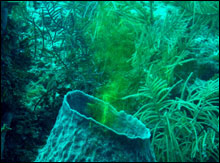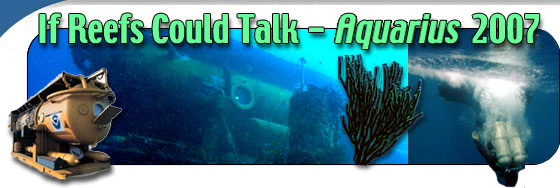Error processing SSI file
|
It's a Sponge, Bob!
This mission has two separate science teams working at Conch Reef. One consists of the four aquanauts who will be working on experiments around the clock to improve our understanding of the role of sponges in the coral reef ecosystem. The other is a team that will work from surface boats, making short dives each day to track the health of Conch Reef by repeating measurements of coral, sponges, algae, and fish that have been made at this location since 1994.
 |
|
Barrel sponge pumping dyed water. (Photo: Steve Gittings)
|
Sponges are composed of a number of different kinds of cells, connective structures, and water canals. Some cells, called choanocytes, line the canals and have hair-like structures called flagella. By moving the flagella, the cells allow water to sucked through tiny holes in the porous colony, into larger canals, and send it shooting out through large holes. It’s hard to see with the naked eye, but add some dye to the water surrounding the sponge and your senses are in for a feast! By studying the filtering rates of sponges, we will get a better idea of just how important they are to the water of the reef.
In addition, the aquanauts will measure changes in water chemistry as it moves through a sponge. From earlier work, it is known that sponges produce wastes like any other animal (did I mention that sponges were animals?). Enough waste is generated that sponges may actually “fertilize” the reef, enhancing the growth of algae, which can then effectively compete for space because of its rapid growth rate, and negatively affect corals – normally the building blocks of the reef.
Does that make sponges the bad guys? It doesn’t seem likely. Sponges are common on many coral-dominated reefs that have very little algae cover. What keeps the algae in check? Maybe fish. Maybe sea urchins. Maybe other animals that graze the plants. When a reef is unhealthy, are these relationships somehow out of balance? Whatever the case, there is clearly much to learn about the dynamics and interactions between the major groups of animals and plants that make up this diverse ecosystem. That is what the aquanauts will be focusing on during this mission.
Another group of divers will be working from a day boat, using tape measures, quadrats, writing slates and cameras to measure the current populations of corals, sponges, algae, and fish on Conch Reef. This work started at this location in 1994. Repeated visits are telling us how the deeper portions of reefs in the Florida Keys are changing. Direct comparison of data at long-term “sentinel” sites like those in Carpenter Basin are one of the ways scientists and managers can track reef condition. These sites are also places where we can track the effectiveness of management actions by the many agencies working to keep south Florida ecosystems healthy and productive.
During the mission, our observations and some preliminary findings will be posted on the website. If you have questions, you are invited to submit them by email. We will try our best to get you an answer!
|



